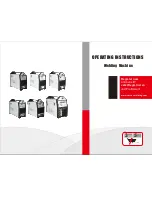
WSHP-SVX01E-EN
53
Installation
2.
With the addition of a shut-off
device on the supply and return
of the system, the unit may be
isolated during service or
maintenance situation. This
system may be installed as a
wide open (full water flow to the
equipment) design, or manually
balanced by utilizing the
pressure/temperature ports on
the top of the ball valve/shut-off
device.
3.
A circuit setter provides a means
of manually balancing the water
flow to the heat pump. This
manual in-line balancing method
is accurate up to ±20%. In order
to determine flow rate, the user
must record both handle
position, and differential
pressure drop. Then, the user
must consult a chart containing
both pieces of information and
make the necessary adjustments
to the circuit setter.
4.
For self balancing flow control, a
Hays Measurflo® balancing hose
kit provides a constant flow rate
over the pressure differential
range of 2 to 80 psid. As system
pressures change (through the
addition of heat pumps, for
example) each individual flow
control valve will automatically
Figure 56.
Flexible hoses with ball
valves
Figure 57.
Flexible hoses with ball
valves and circuit setter
adjust to the new system
conditions.
Additional accessories, such as a
strainer are recommended for use to
eliminate contaminants from
entering the co-axial water-to-
refrigerant heat exchanger.
Cleaning and Flushing
the Water Loop
After the piping system is complete,
the flexible hose connectors should
be doubled back to complete the
water circuit external to the unit
(avoiding trash settle-out in the
condenser). An extra pipe may be
necessary to connect the hose kits.
1.
Water circulation system should
be filled with clean water using
the water make up connections.
Note: Air vents should be open
during filling.
2.
With the air vents closed, start
the circulating pump and then
crack the air vents to bleed off
the trapped air, assuring
circulation through all
components of the system.
Note:
Make up water must be
available to the system to
replace the volume formerly
occupied by the air that is
bled off.
3.
With the air vented and the water
circulating, the entire system
should be checked for leaks with
repairs made as required.
4.
Operate the supplementary heat
system (boiler) making checks
per manufacturer’s instructions.
During this operation, visual
checks should be made for leaks
that may have occurred due to
increased heat. Repair as
required.
5.
Open the system at the lowest
point for the initial blow down
(making sure the make up water
Figure 58.
Flexible hoses with ball
valves
is equal to the water being
dumped). Continue blow down
until the water leaving the drain
runs clear, but not less than 2
hours.
6.
Shut down pumps and
supplementary heat system.
Reconnect the hoses placing the
water-to-refrigerant heat
exchanger in the water
circulating system.
Note:
Vents should be open when
the pumps and
supplementary heat system
are shut down.
Summary of Contents for Axiom GEHB 006
Page 88: ...88 WSHP SVX01E EN Figure 1 Basic 208 V 60 Hz 1Ph Wiring...
Page 89: ...WSHP SVX01E EN 89 Wiring Figure 2 Deluxe 380 420 V 50 Hz 3 Ph...
Page 90: ...90 WSHP SVX01E EN Wiring Figure 3 ZN510 208 V 60 Hz 1 Ph...
Page 91: ...WSHP SVX01E EN 91 Wiring Figure 4 ZN524 460 V 60 Hz 3 Ph...
Page 95: ......
















































